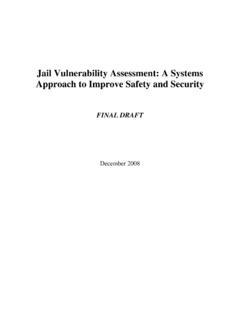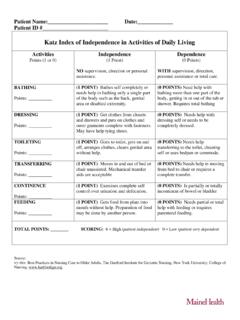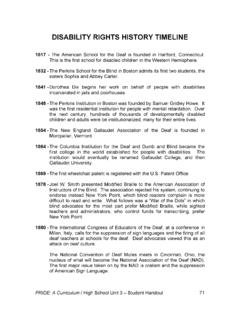Transcription of CORE JAIL STANDARDS I. SAFETY - correction
1 CORE JAIL STANDARDS I. SAFETY GOAL: Provide a safe environment for the community, staff, volunteers, contractors and inmates. PERFORMANCE STANDARD: Protection from Injury and Illness 1A. The community, staff, volunteers, contractors and inmates are protected from injury and illness in the workplace. EXPECTED PRACTICES Sanitation Inspections 1-CORE-1A-01 (Mandatory) (Ref. 4-ALDF-1A-01) The facility complies with all applicable laws and regulations of the governing jurisdiction. The following inspections are implemented: weekly sanitation inspections of all facility areas by a qualified departmental staff member comprehensive and thorough monthly inspections by a SAFETY /sanitation specialist at least annual inspections by qualified persons Comment: None. Protocols: Written policy and procedure. Sanitation and SAFETY inspection checklists. Laws and regulations.
2 Process Indicators: Completed inspection checklists and reports. Documentation of corrective action. Inspection reports. Disposal of Material 1-CORE-1A-02 (Mandatory) (Ref. 4-ALDF-1A-02) Disposal of liquid, solid, and hazardous material complies with applicable government regulations. Comment: None. Protocols: Written policy and procedure. Written plan. Internal health/sanitation inspection checklists that include solid waste issues. 2 American Correctional association Process Indicators: Plan that has been approved by regulatory agency. Trash disposal contract. Completed inspection reports/forms, including documentation than identified deficiencies were corrected. Observation. Vermin and Pests 1-CORE-1A-03 (Mandatory) (Ref. 4-ALDF-1A-03) Vermin and pests are controlled. Comment: None. Protocols: Written policy and procedure. Control plan. Process Indicators: Pest control contracts.
3 Maintenance agreements. Trash disposal contracts. Inspection reports, including documentation that identified deficiencies were corrected. Housekeeping 1-CORE-1A-04 (Ref. 4-ALDF-1A-04) The facility is clean, in good repair. Comment: None. Protocols: Written policy and procedure. Housekeeping plan. Maintenance plan. Inspection forms. Inmate handbook (describing inmate responsibilities). Process Indicators: Inspection reports, completed forms, including documentation that identified deficiencies were corrected. Water Supply 1-CORE-1A-05 (Mandatory) (Ref. 4-ALDF-1A-07) The facility s potable water source and supply, whether owned and operated by a public water department or the facility, is certified at least annually by an independent , outside source to be in compliance with jurisdictional laws and regulations. Comment: None. Protocols: Written policy and procedure.
4 Process Indicators: Documentation of approval by outside source. Documentation of credentials of person/agency providing approval. Single-Occupancy Cells (Size) 1-CORE-1A-06 (Existing, Renovation, Addition, New Construction) (Ref. 4-ALDF-1A-09) 3 American Correctional association Single cells provide at least 35 square feet of unencumbered space. At least 70 square feet of total floor space is provided when the occupant is confined for more than ten hours per day. Comment: Unencumbered space is usable space that is not encumbered by furnishings or fixtures. At least one dimension of the unencumbered space is no less than seven feet. In determining the unencumbered space, the total square footage is obtained and the square footage of the fixtures is subtracted. All fixtures must be in operational position for these calculations. Protocols: Written policy and procedure.
5 Facility plans/specifications. Process Indicators: Measurement. Observation. Multiple-Occupancy Rooms/Cells (Size) 1-CORE-1A-07 (Existing, Revocation, Addition, New Construction) Ref. 4-ALDF-1A-10) Multiple-occupancy rooms/cells house between two and sixty-four occupants and provide 25 square feet of unencumbered space per occupant. When confinement exceeds ten hours per day, at least 35 square feet of unencumbered space is provided for each occupant. Comment: Unencumbered space is usable space that is not encumbered by furnishings or fixtures. At least one dimension of the unencumbered space is no less than seven feet. In determining the unencumbered space, the total square footage is obtained and the square footage of the fixtures is subtracted. All fixtures must be in operational position for these calculations. Protocols: Written policy and procedure. Facility plans/specifications.
6 Process Indicators: Measurement. Observation. Dayrooms (Size) 1-CORE-1A-08 (Existing, Renovation, Addition, New Construction) (Ref. 4-ALDF-1A-12) Dayrooms with space for varied inmate activities are situated immediately adjacent to inmate sleeping areas. Dayrooms provide a minimum of 35 square feet of space per inmate (exclusive of lavatories, showers, and toilets) for the maximum number of inmates who use the dayroom at one time. No dayroom encompasses less than 100 square feet of space, exclusive of lavatories, showers, and toilets. Comment: None. Protocols: Written policy and procedure. Facility plans/specifications. Process Indicators: Measurement. Observation. Interviews (staff, inmates). Housing and classification records/logs. 4 American Correctional association Environmental Conditions/Lighting 1-CORE-1A-09 (Ref. 4-ALDF-1A-14, 1A-15) All inmate rooms/cells provide the occupants with access to natural light.
7 Lighting throughout the facility is sufficient for the tasks performed. Comment: None. Protocols: Written policy and procedure. Facility plans/specifications. Process Indicators: Documentation from a qualified source. Measurement. Observation. Maintenance and repair records. Inmate and staff interviews. Ventilation 1-CORE-1A-10 (Ref. 4-ALDF-1A-19, 1A-20) A ventilation system supplies at least 15 cubic feet per minute of circulated air per occupant, with a minimum of five cubic feet per minute of outside air. Toilet rooms and cells with toilets have no less than four air changes per hour unless state or local codes require a different number of air changes. Air quantities are documented by a qualified independent source and are checked not less than once per accreditation cycle. Temperatures are mechanically raised or lowered to acceptable comfort levels Comment: Accreditation cycle is defined as within the past three years.
8 Protocols: Written policy and procedure. Facility plans/specifications. Process Indicators: Measurement. Observation. Inmate and staff interviews. Facility logs and records. Maintenance and repair records. Report from independent source. Smoking 1-CORE-1A-11 (Ref. 4-ALDF-1A-21) Non-smoking inmates are not exposed to second-hand smoke. Comment: Research confirms the adverse health effects of environmental tobacco smoke (second hand smoke). Protocols: Written policy and procedure. Inmate handbook, rules. Process Indicators: Observation. Staff and inmate interviews. Facility logs and records. 5 American Correctional association PERFORMANCE STANDARD: Vehicle SAFETY 1B. Vehicles are maintained and operated in a manner that prevents harm to the community, staff, contractors, volunteers, and inmates. EXPECTED PRACTICES Vehicles/Inmate Transport 1-CORE-1B-01 (Ref.)
9 4-ALDF-1B-03, 1B-04, 1B-06) Transportation of inmates outside the facility, and security of facility vehicles are governed by policy and procedure. Staff involved with transportation of inmates are informed of all policy and procedures. Annual SAFETY inspections are conducted on all vehicles used by the facility. Repairs are completed immediately. Vehicles are not used until repairs are complete. Comment: None. Protocols: Written policy/procedure. Vehicle log format. Maintenance record format. Staff training curriculum. Process Indicators: Inspection reports. Completed vehicle logs. Maintenance records and receipts. Reports of vehicle problems/requests for repair or maintenance. Credentials of inspector. Documentation of completed repairs. Documentation of staff training and qualifications. Transport logs. Staff and inmate interviews. PERFORMANCE STANDARD Emergency Preparedness/Response 1C.
10 The number and severity of emergencies are minimized. When emergencies occur, the response minimizes the severity. Definition: An emergency is any event that results in the suspension or disruption of normal facility operations. EXPECTED PRACTICES Emergency Plan 1-CORE-1C-01 (Mandatory) (Ref. 4-ALDF-1C-01, 1C-05, 1C-06) There is a plan that guides the facility response to emergencies. All facility personnel are trained annually in the implementation of the emergency plan. The emergency plan should include procedures to be followed in situations that threaten facility security. Such situations may include but are not limited to: riots/disturbances, hunger strikes, escapes, taking of hostages, and staff work stoppage. 6 American Correctional association Comment: None. Protocols: Written policy and procedure. Emergency plans. Training curriculum. Distribution list for plan.






